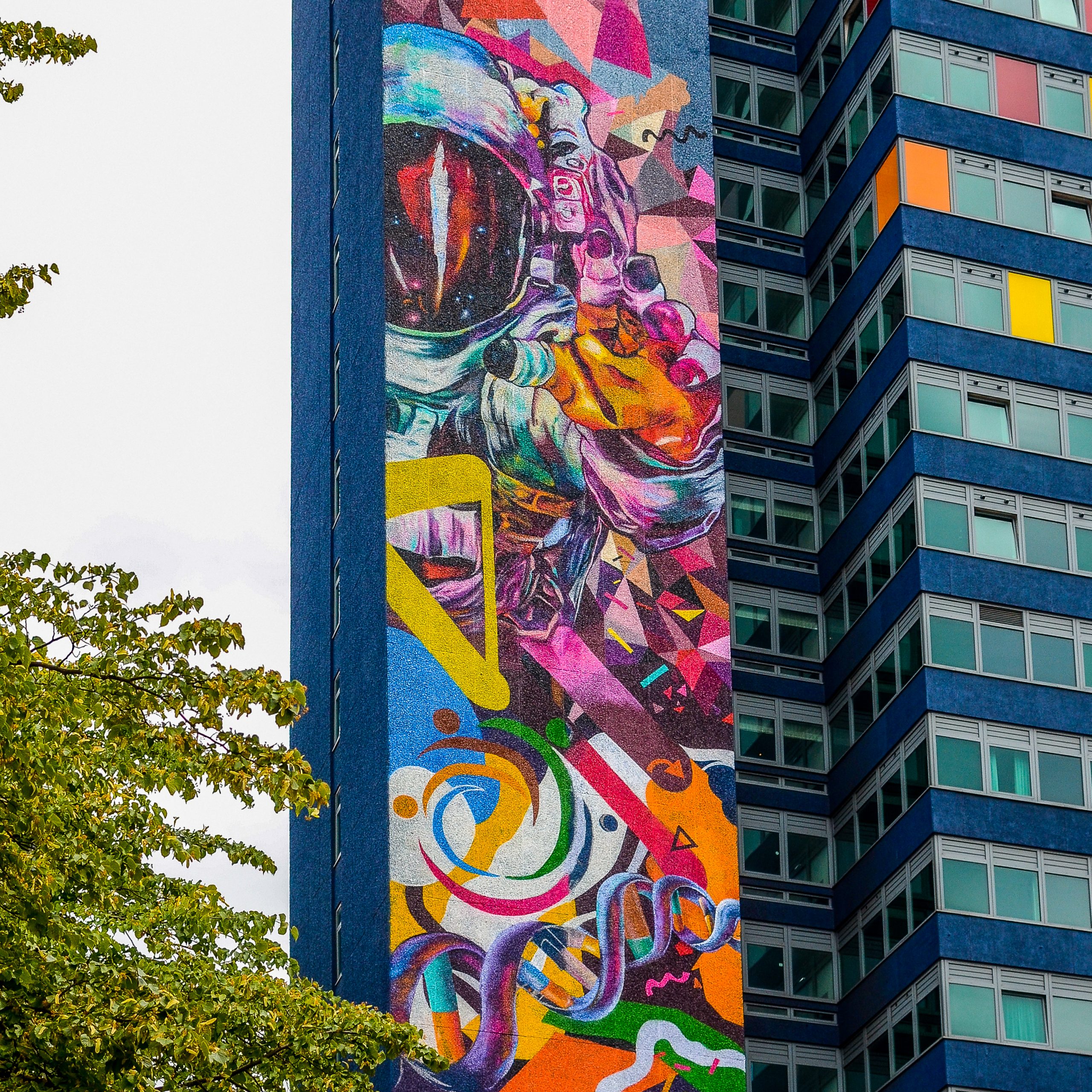
July 2022 saw the transformation of Leicester’s St. George’s tower, colloquially known as the Blue Tower and located at the top of Granby Street, as the iconic building became home to Europe’s tallest piece of street art.
The project, funded by BID Leicester, has been developed alongside local arts organisation Graffwerk, which has been involved in the project from conception to delivery. The sky-scraping artwork was painted by a team of Leicester-based artists; Wing Lo, Richard Peacock, Leigh Drummond, assisted by Ben Edwards & Kiene Tuckley.
The mural stands at an impressive 82 metres tall, almost doubling the current UK record and covering a total of 717.5 square metres, making it one of the tallest murals in the world – surpassed only by paintings in Calgary, Canada and Karachi, Pakistan.
The artwork incorporates vibrant colours, bold graphic elements, and visual themes that meaningfully represent various aspects of Leicester’s unique heritage and culture.
At the top of the tower, which is visible at many locations within the city centre and at viewpoints much further afield, is the profile of a fox – an iconic emblem of Leicester and its iconic ‘Foxes’ football team.
Further down the tower, an astronaut with outreached hand can be seen in striking clarity and detail, representing Leicester as the home of the National Space Centre and a world leader for space research.
The piece also features a strand of DNA, alluding to the University of Leicester’s discovery of the technique of DNA fingerprinting and, more recently, for the identification of the bones of Richard III.
At the bottom of the mural, viewers can find a colourful tiger, representing the world-famous Leicester Tigers rugby union club.

The Artists
The tower was painted by a team of Leicester based artists, Wing Lo, Richard Peacock, Leigh Drummond, assisted by Ben Edwards & Kiene Tuckley. Watch the video below to hear their thoughts on scaling the 82-meter tower and see some stomach-churning views from the top.
Leicester’s Heritage
Leicester has a rich and diverse history and culture. The iconography of the tower reflects this. Keep reading to learn more.

The Fox
The fox is an iconic Leicester emblem.
Leicestershire is considered to be the birthplace of fox hunting, with the Quorn Hunt being established in the 1600’s. Leicester City Football Club are known as ‘The Foxes’, and incorporated a fox as their emblem in 1948. Filbert Fox has been Leicester City Football Club’s mascot since 1992.
So, it was only right that a striking red fox would be at the top of the tower and visible for miles, including from the top of Old John at Bradgate Park!
The Astronaut
From the first space research group founded at Leicester University in 1960, Leicester has had a long history of pioneering space research, with many discoveries have been made in space using Leicester-built instruments, including the first stellar black hole in 1975. Leicester is also home to the National Space Centre, which opened in 2001.
Diversity symbol
Leicester has a long history of welcoming new arrivals, and studies have shown that Leicester is home to 240 faith groups across 14 different faiths and beliefs with over 70 languages spoken in the city.


DNA
The University of Leicester’s renowned research includes the discovery by Professor Sir Alec Jeffreys of the technique of DNA fingerprinting and, more recently, the identification of the bones of Richard III.
The Tiger
Leicester Tigers are the most successful team in English Rugby, and have the biggest crowds of any team in the UK. The club was formed in 1880 at the George Hotel in Leicester, and almost since inception has been known as The Tigers, with the name came from their chocolate and orange kit.
The project is part of BID Leicester’s continuing mission to improve the city centre for those who work, live, and visit by creating a more attractive environment. Evolving over three years of planning and securing permissions, the project has seen the transformation of one of Leicester’s most controversial buildings, an iconic but contentious landmark which has been described as unsightly by many, into a beacon of civic creativity, ambition, and pride.
